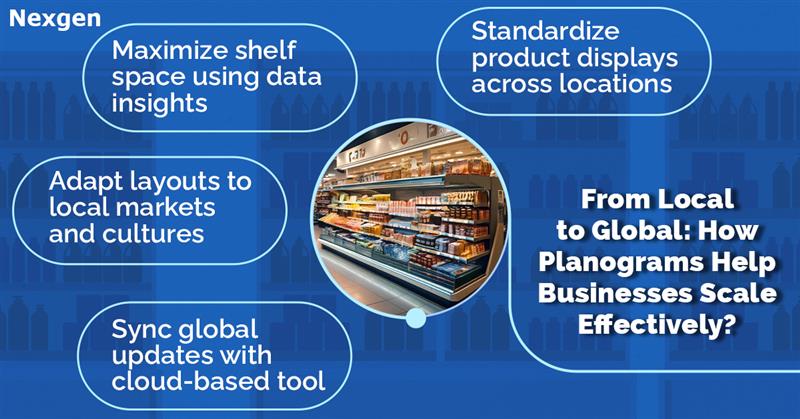Scaling a business from a local operation to a global enterprise can be a difficult task. As companies expand their reach, they must maintain consistency in their product offerings, enhance operational efficiency, and create cohesive customer experiences across all locations. Planograms, the visual representations of store layouts and product placements, are one of the most effective tools businesses can use to ensure smooth scaling across multiple stores, regions, and even countries. In this blog, we will explore how planogram services play a crucial role in helping businesses scale effectively from local to global markets, ensuring that the transition is seamless, profitable, and customer- centric.

1. Standardizing product placement across locations.
One of the key challenges when expanding a business is maintaining consistency in product presentation across various locations.
Planograms provide a standardized blueprint for how products should be displayed on shelves, ensuring that every store, whether in a local neighborhood or across the globe, adheres to the same layout. This consistency is crucial for global brands, as customers expect the same shopping experience no matter where they are. With planograms, businesses can:
- Ensure uniformity in how products are organized and displayed, which reinforces brand identity.
- Tailor product placements to local preferences while keeping global branding intact.
- Streamline stock management and avoid inconsistencies in product availability.
2. Optimizing shelf space for efficiency.
As businesses scale, so do their operational needs. With a growing number of stores, it becomes increasingly important to optimize shelf space efficiently to maximize product visibility and sales. Planograms provide businesses with a visual tool to optimize every inch of shelf space, ensuring that each product is placed in the most effective position for customer engagement. Planogram allows businesses to:
- Maximize the use of shelf space, which leads to higher sales per square foot.
- Utilize data-driven insights to determine the most effective product placements based on customer preferences and purchasing behavior.
- Integrate new products or seasonal items without disrupting existing layouts, ensuring that new products are introduced seamlessly.
3. Adapting to local preferences and cultural differences.
As businesses expand globally, they encounter new markets with different customer needs, tastes, and cultural influences. Planograms offer a flexible framework that can be adapted to suit local preferences while maintaining overall consistency in product presentation. With planograms, businesses can:
- Tailor product displays based on regional preferences, such as placing certain food items, clothing, or electronics in specific locations based on local demand.
- Adjust visual elements like signage, colors, or promotional content to resonate with local audiences while staying true to the global brand.
- Quickly test new products or promotional strategies in specific markets before rolling them out globally.
4. Leveraging technology for global consistency.
Modern planogram software offers sophisticated tools that allow businesses to manage and scale their operations seamlessly. Cloud-based platforms enable real-time updates and collaboration across different teams, ensuring that changes to planograms are communicated and implemented instantly across all locations, no matter their size or geographic location. Through technology, businesses can:
- Automated planogram updates, ensuring that new products, promotions, or seasonal displays are rolled out across all locations simultaneously.
- Use data analytics to monitor planogram performance in real-time, enabling businesses to adjust layouts quickly and effectively based on customer behavior or market conditions.
- Collaborate with regional teams to customize planograms for local stores while maintaining global standards.
Overview of Nexgen Planogram Services
Nexgen offers store-specific planograms for clients that optimize sales and achieve category objectives. We create customized planograms for your business to ensure that these are better aligned with your goals and merchandising strategies. Our expertise in planogram automation helps us build planograms faster, better and more consistently. Whether it is creating a planogram from scratch, or a typical reset, we have the knowledge, tools, and experience to get the job done for you.
Get in Touch with us!